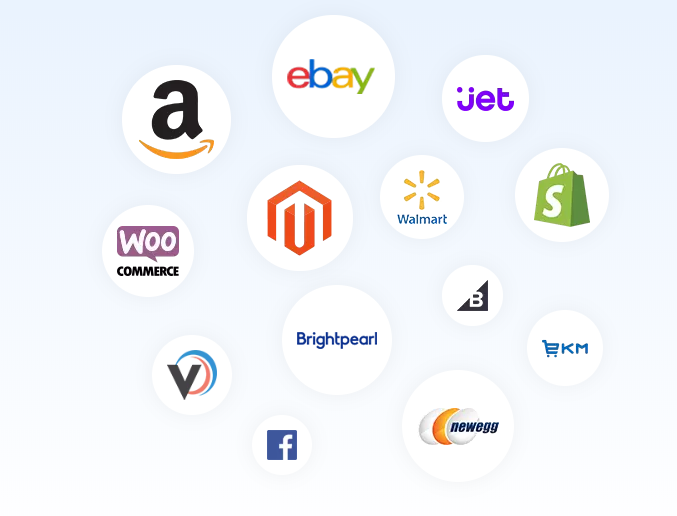Selling on multiple platforms – why should you consider it?
Selling on multiple platforms – why should you consider it?
As you may already know, more and more people tend to shop online, rather than offline nowadays. Why you might ask? It’s more convenient and it’s easier than driving to the store, getting stuck in traffic, etc. Most people choose to purchase products from the comfort of their homes. It’s simply more convenient.
This is exactly why you, as a seller, need to get more exposure for your products. You might be selling an amazing selection of products at great prices, but if your potential customers aren’t aware of it, what’s the point? This is we highly recommend displaying you products on as many eCommerce platforms as possible. More exposure = more sales – it really is that simple.
Exposure?
Yes, exposure of your products. Try to have them on all major eCommerce platforms. Think about it like this: many online shoppers have a platform preference. For example, I know people that will shop on Amazon and never touch eBay, even if the prices are cheaper. This could also be the other way around – people that only shop on eBay and never even bother to look on Asos or Amazon.
This is why you need to have your products on all platforms: eBay, Amazon and even Shopify/Magento/WooCommerce (if you own a website).
Our recommendation
First of all, expand your business and your products to multiple channels – this is your priority. Even though at first it might seem a bit frightening with inventory management, multiple fees, store subscriptions, order management, etc. But once you have all of these figured out, your products will have greater visibility and exposure.
Every single time you expand to a new channel or platform, the number of potential customers you can reach effectively doubles or triples. The number of your possible customers grows exponentially.
Keep your customers satisfied and loyal!
In order to keep your customers satisfied, it’s important to know them and what they want. Although good marketing research will give you great insight into what they want, having actual customer feedback is the best way to ensure you’re using the right strategy.
We’d recommend sending out quick surveys. These allow you to get your customer’s specific point of view and opinions – that is if you can get them to actually complete the survey. Simply send out a thank you email once your customers receive the goods, and ask them about their experience. Have them rate your services, i.e.:
Shipping – 1 to 5 stars
Pricing – 1 to 5 stars
Item description – 1 to 5 stars
And add an empty field at the end, where your customers can type suggestions. (Make this field optional, don’t force your customers to write something if they don’t want to!)
Take into consideration what your customers are saying
Now that you have your customer’s opinions, take them into consideration. Take a look at why the shipping took so long or why there were errors in the product description. Now apply this newly gathered information to all of your channels. Was there an issue with some pictures or a line in the description? Fix it on all of your channels, not just one. Even though this might look like common sense, some sellers don’t do it.
Which channels should you consider?
With so many eCommerce platforms to choose from, you need to take a look into them and choose wisely. Take into consideration the type of products that you’re selling and adjust accordingly.
A few great examples would be Amazon, eBay, Newegg UK and even Etsy. Then you also have platforms such as ManoMano for tools and hardware. It really comes down to what you are selling and how much money you want to invest.
Review your pricing structure
If you’re considering selling on multiple platforms, one key aspect is price. You can’t have the same price across all platforms! Maybe one platform has different fees from another. Or maybe shipping costs are different on these platforms.
You have to adjust your price accordingly when selling on multiple platforms. This is why we would recommend having tailored prices for each channel. Also, if you pay a commission for your sales, you will need to take into consideration as well. Let’s give an example: Maybe on Amazon you have a few competitors that offer the same product at better prices – you will have to adjust your price to match them or even have a lower price. Then on eBay maybe you don’t have as many competitors, so you can keep a higher price – it depends.
This is exactly why we recommend analyzing each market carefully. Analyze your competitors and their prices. Evaluating the trends can also be very rewarding. While trends keep changing, you can identify the loopholes and add products accordingly.
To sum up
Selling on multiple platforms can be scary at first, with many potential problems arising. These can be inventory management problems or even issues with stock syncing throughout your platforms. But if you manage to overcome these, your business could expand more than you’d think.
Expanding on multiple channels can help you build a brand and increase your revenue drastically. Remember the golden rule: more exposure = more potential customers = more sales.

Ad-Lister can help your business by expanding your products to multiple channels. It can integrate with platforms such as Amazon, eBay, WooCommerce, Shopify, Magento, Etsy, Newegg, Brightpearl and many, many more. It allows you to manage your products and then upload them to multiple sales channels within seconds. If selling on multiple platforms sounds good to you, giving Ad-Lister a try could be well worth your time.
Take a look at how many eCommerce platforms are out there, and see what you’ve been missing on.


